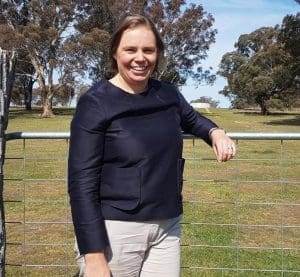
Rabobank commodity analyst Georgia Twomey
SHEEP meat and wool demand will remain strong for the next five years, but growth will depend on accessing new markets, especially younger millennial consumers, a Rabobank report said today.
The report ‘The Sheep is Back’ by Rabobank commodity analyst Georgia Twomey said demand for Australia’s sheep products – meat and wool – is set to remain strong.
However, the future strength of this demand hinged on the industry’s ability to tap into new segments of the market. The report identified the ‘millennial’ consumer – meat eaters currently aged 18-38 years – as offering some of the greatest opportunities for value growth.
The report recommended sheep producers focus on transparency, quality and flexibility to boost lamb’s value proposition in the face of competing proteins.
Ms Twomey said not only are millennials rapidly becoming the largest consumer base in the market, but many of their purchasing behaviours — driven by their preference for quality, authenticity and transparency — are characteristics inherent to lamb and wool.
“Sheep products already operate in a relatively niche market, making lamb and wool unique in the protein and fibre space.
“With millennials willing to try new products, and in some cases pay more for them, there is real opportunity for those in the sheep industry to leverage the existing characteristics of their product and capitalise on this new demand.”
Ms Twomey said sheep product demand growth will be driven by two key components – with traditional consumer markets providing the platform for strong volume growth, while the new millennial consumer group will drive the high value growth for products.
“Meat and wool have slightly different traditional consumer bases, but both share the common trait of being longstanding, established markets.
“For sheep meat, the traditional consumer tends to be a particular geographic location or ethnicity – namely, the Middle East, China, US and the EU – while apparel wool has traditionally been targeted at high-income consumers in the northern hemisphere, with China the world’s largest processor, textile exporter and, due to the scale of population, user of wool at retail,” she said.
However, Ms Twomey said millennial generation exhibited characteristics in the way they shop and consume that the sheep industry is well-positioned to meet.
“Representing nearly a third of the population in countries such as the US and China, millennials are not only becoming the largest consumer base but their influence is set to grow as they move further into the workforce and their purchasing power increases,” she said.
“Desire for quality is one of the key purchasing drivers of this age group, along with authenticity, uniqueness and transparency in the production process.
“While other factors include their willingness to try new things, convenience, the higher tendency to eat out of home, and, in recognition of quality, the willingness to pay more,” Ms Twomey said.
Wool is targeting new millennial consumers
Ms Twomey said wool is moving into new product ranges to capture this new consumer, citing activewear as an example.
“This is a huge and growing market, and the headway Merino wool is making with its growing range of innovative products, such as the Allbirds Merino sneaker, highlights the opportunity for this fibre in less price-sensitive markets.”
The Allbirds sneaker is made from New Zealand non-mulesed wool, turned into fabric in Italy and assembled in South Korea.
Lamb producers need to know new consumer standards
In the lamb market, the Rabobank report looked at the United States, with recent growth in the fast, casual and quick service restaurant trade.
“Lamb not only taps into the growing trend to eat out of home, as a unique item on the menu, but also lends itself as a protein of choice in the ready-prepared meal kits.
“That said, the competition from alternative proteins and fibres is set to increase, making it increasingly important for wool and lamb to justify their value proposition to users,” Ms Twomey said.
This applied particularly to lamb, where competition is not only from other proteins such as poultry, pork and beef but also from alternatives such as plant-based proteins, insect proteins or lab-grown meats, she said.
“In light of this, sheep producers need to keep abreast of what is driving consumer trends and continually look at ways to position their product to capitalise on this new demand.
“For example, striving for greater transparency through the supply chain to not only guarantee specific quality attributes, but also social, animal welfare and environmental standards, is one way to position for future growth. Another is remaining flexible and ready to adapt to changing consumer demands through maintaining some diversity in marketing options and forging closer relationships along the supply chain.”
Demand growth set to continue
Ms Twomey said Rabobank’s view is the demand outlook for the coming five years remains strong for the Australian sheep industry and that growth will continue.
Citing strong demand in global markets as the driver for higher prices and strong returns for Australian sheep producers — with per unit export values of wool and lamb, 42 and 23 percent, respectively, above the five-year average — Ms Twomey said supply-side impacts will also influence prices and producers’ ability to capture increased demand.
“While this report focusses on the growth prospects for demand, the supply of wool and lamb – both locally and globally – is expected to remain constrained, which will also help with supporting prices in the medium-term,” she said.
The full Rabobank report is only available to Rabobank customers.

HAVE YOUR SAY